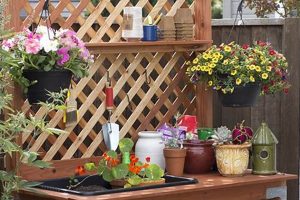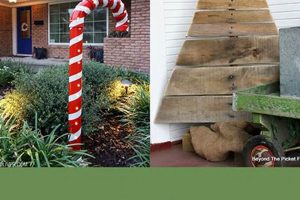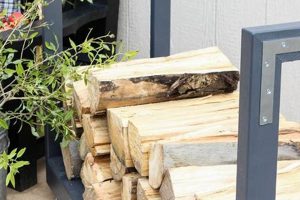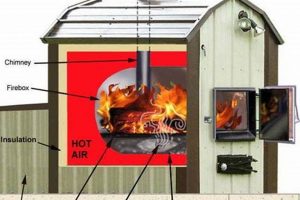A structure created at home for air-drying laundry constitutes a do-it-yourself approach to a traditional method. Typically located in an outdoor space, this construction provides an alternative to electric or gas-powered dryers. Examples include a simple line strung between two trees, a freestanding T-post structure, or a more elaborate pulley system.
Utilizing a homemade system offers several advantages. Energy consumption is reduced, leading to lower utility bills and a smaller carbon footprint. Fabrics can benefit from the natural air drying process, potentially extending their lifespan and reducing the need for ironing. Furthermore, this practice connects individuals to a sustainable and time-honored domestic activity, reflecting resourcefulness and environmental consciousness. Historically, this method was the primary means of drying clothing before the advent of modern appliances.
The subsequent sections will detail various designs, construction methods, material selections, and maintenance considerations relevant to creating an effective and durable drying solution. Specific attention will be given to optimizing placement for sunlight and airflow, ensuring structural integrity, and mitigating potential challenges such as weather exposure and space constraints.
Essential Considerations for Homemade Laundry Drying Structures
Constructing a reliable and efficient system for air-drying garments requires careful planning and execution. The following guidelines aim to provide valuable insights for creating a successful installation.
Tip 1: Site Selection: Prioritize locations that receive ample sunlight throughout the day. South-facing positions are generally optimal, maximizing solar exposure. Ensure the area is also relatively free from obstructions that could inhibit airflow.
Tip 2: Material Durability: Select weather-resistant materials for all components. Pressure-treated lumber, galvanized steel, or stainless steel offer enhanced protection against corrosion and degradation caused by outdoor elements.
Tip 3: Secure Anchoring: Proper anchoring is crucial for structural stability. Utilize concrete footings or ground anchors appropriate for the soil conditions and the expected load. Verify the anchors are adequately buried and secured.
Tip 4: Line Tension and Sag: Avoid excessive sag in the lines. Employ tensioning devices, such as turnbuckles, to maintain optimal tautness. Excessive sag can lead to garments dragging on the ground or uneven drying.
Tip 5: Line Material Considerations: Opt for clothesline materials resistant to stretching, sagging, and UV degradation. Vinyl-coated steel cable or specialized synthetic ropes designed for outdoor use are recommended.
Tip 6: Height Optimization: Determine an appropriate height based on the length of garments typically dried. Ensure sufficient clearance between the lowest hanging clothes and the ground to prevent soiling.
Tip 7: Regular Maintenance: Inspect the structure periodically for signs of wear or damage. Tighten loose connections, replace worn-out lines, and apply protective coatings as needed to prolong the system’s lifespan.
Implementing these guidelines will contribute to a more robust, efficient, and long-lasting system. Proper planning and diligent execution are paramount to achieving optimal performance and minimizing maintenance requirements.
The subsequent section will explore advanced design options and alternative materials to further enhance the functionality and aesthetic appeal of your drying installation.
1. Stability
The structural integrity of a homemade laundry drying apparatus directly dictates its functional lifespan and safety. Instability can lead to collapse, rendering the system unusable and potentially causing damage to garments or creating a hazard. Several factors contribute to the stability of such a structure, including the depth and composition of footings, the quality of joinery or connections, and the overall design of the frame. For example, a line strung between two slender trees without adequate reinforcement is inherently unstable, prone to sagging or even complete failure under the weight of wet clothing.
Conversely, a well-engineered structure, incorporating concrete footings and securely fastened support posts, provides a robust and dependable drying solution. Consider a T-post design; if the vertical post is not deeply embedded and firmly anchored, wind or the weight of heavy items (such as blankets) can cause it to lean or topple. Similarly, a complex, multi-line system requires carefully calculated load distribution to prevent overloading any single component. The selection of appropriate hardware (brackets, bolts, cables) is also critical; undersized or low-quality fasteners can weaken the structure, leading to premature failure.
In summary, stability is a non-negotiable requirement for a successful installation. Ignoring this aspect results in a system that is not only ineffective but also potentially dangerous. Proper planning, careful construction, and the use of durable materials are essential to ensure that the clothes drying structure remains a reliable and safe resource for years to come. The challenge lies in balancing cost-effectiveness with the need for a structurally sound design, requiring careful assessment of site conditions and anticipated usage.
2. Materials
The selection of materials directly influences the functionality, longevity, and aesthetic integration of a homemade laundry drying structure. The constituent components, from the support posts to the drying lines themselves, must withstand constant exposure to environmental factors such as sunlight, moisture, temperature fluctuations, and, in some regions, extreme weather conditions. Inadequate material choices can lead to premature degradation, structural failure, and increased maintenance demands, ultimately negating the cost savings associated with a do-it-yourself approach. For instance, untreated wood used for support posts will succumb to rot and insect infestation, necessitating frequent repairs or complete replacement. Similarly, a clothesline made from a non-UV resistant material will quickly become brittle and prone to snapping, rendering the system unusable.
Practical applications of appropriate material selection are evident in various designs. Pressure-treated lumber or naturally weather-resistant wood species like cedar or redwood offer extended lifespans for support structures. Galvanized steel pipes or stainless steel components provide superior resistance to corrosion in humid environments. Drying lines constructed from vinyl-coated steel cable or specialized synthetic ropes exhibit minimal stretching and UV degradation, ensuring consistent tension and preventing premature failure. Furthermore, the choice of hardware, such as stainless steel hooks, turnbuckles, and fasteners, minimizes rust and maintains structural integrity. An understanding of material properties allows for informed decisions that balance cost-effectiveness with long-term performance.
In conclusion, material selection is a critical determinant of the success of any homemade laundry drying apparatus. Thoughtful consideration of environmental factors, load-bearing requirements, and maintenance expectations is essential. While budget constraints may influence choices, prioritizing durability and weather resistance over short-term cost savings yields a more sustainable and reliable drying solution. The challenge lies in identifying materials that offer an optimal balance of performance, cost, and aesthetic appeal, contributing to a structure that effectively meets drying needs while seamlessly integrating into the outdoor environment.
3. Sunlight Exposure
Sunlight exposure is a critical factor in the design and placement of a homemade system for drying laundry. Solar radiation provides the energy necessary for water evaporation, thereby facilitating the drying process. The degree of exposure directly influences the efficiency and effectiveness of the apparatus.
- Evaporation Rate
Direct sunlight accelerates the evaporation of moisture from fabrics. Ultraviolet radiation contributes to breaking down water molecules, speeding up the drying time. A location with minimal sunlight necessitates a longer drying period and may result in damp or musty-smelling clothes. Conversely, maximizing sun exposure reduces the reliance on alternative drying methods such as electric dryers, promoting energy conservation.
- Sanitization
Ultraviolet radiation possesses sanitizing properties, aiding in the elimination of bacteria and microorganisms present in fabrics. Direct sunlight acts as a natural disinfectant, contributing to the cleanliness and hygiene of dried laundry. Garments dried indoors or in shaded areas lack this sanitizing effect, potentially harboring residual bacteria. This is particularly relevant for items such as bedding and towels.
- Color Fading
Prolonged and intense sunlight exposure can cause fading of colored fabrics. Ultraviolet radiation can break down dye molecules, leading to a gradual loss of color intensity. This effect is more pronounced in darker or more vibrant colors. Implementing strategies to mitigate excessive sunlight exposure, such as rotating garments or utilizing partially shaded areas, can minimize color fading while still benefiting from the drying properties of the sun.
- Optimal Placement
Selecting a location that receives unobstructed sunlight for the majority of the day is essential for maximizing the effectiveness of a homemade drying system. South-facing locations generally offer the best solar exposure. Consideration should be given to potential obstructions, such as trees or buildings, that may cast shadows during peak sunlight hours. Optimizing placement can significantly reduce drying time and improve overall performance.
The interplay between sunlight exposure and fabric characteristics dictates the overall drying outcome. Effective integration of these considerations ensures a more efficient, hygienic, and sustainable approach to drying clothing utilizing a do-it-yourself structure.
4. Line Tension
Line tension is a critical factor influencing the performance and longevity of any homemade laundry drying structure. Inadequate tension results in excessive sag, reducing the usable drying space and potentially allowing garments to touch the ground, thereby soiling them. Conversely, excessive tension can place undue stress on support structures and the lines themselves, leading to premature failure. The relationship between tension and load-bearing capacity is direct; an improperly tensioned line cannot efficiently support the weight of wet clothing, compromising the entire system’s functionality.
The practical significance of understanding line tension is evident in the construction and maintenance of these drying systems. For example, a clothesline strung between two trees without adjustable tensioning mechanisms will naturally sag over time as the line stretches. This requires periodic tightening or replacement of the line. More sophisticated designs, such as those incorporating turnbuckles or pulley systems, allow for precise tension adjustments, accommodating varying loads and environmental conditions. An example of improper tension is a wire clothesline stretched too tautly; during cold weather, the wire contracts, potentially snapping the line or pulling support posts out of alignment.
Achieving optimal line tension requires careful consideration of material properties, span length, and anticipated load. Regular inspection and adjustment are essential to maintain system performance and prevent failures. Ignoring line tension during construction and maintenance results in an inefficient and potentially hazardous drying structure. Proper tensioning not only maximizes drying space and prevents soiling but also prolongs the lifespan of the entire system, enhancing its value as a sustainable and cost-effective laundry solution.
5. Space Efficiency
Space efficiency is a paramount consideration in the design and implementation of any homemade laundry drying system, particularly in urban or suburban environments where outdoor space may be limited. Optimizing the utilization of available area is essential to maximizing functionality without encroaching excessively upon other outdoor activities or aesthetics.
- Vertical Design Utilization
Maximizing vertical space is a key strategy for enhancing space efficiency. High clotheslines, tiered drying racks, or retractable systems that extend upwards rather than outwards allow for greater drying capacity within a smaller footprint. An example is a multi-tiered, A-frame drying rack that can accommodate a significant volume of laundry while occupying a minimal ground area. This approach is particularly beneficial in narrow yards or on balconies.
- Retractable and Foldable Systems
Retractable clotheslines and foldable drying racks offer a dynamic solution for space-constrained environments. These systems can be extended for use when needed and retracted or folded away when not, freeing up the space for other purposes. Wall-mounted retractable lines, for instance, provide a discreet drying solution that minimizes visual impact when not in use. Similarly, foldable drying racks can be easily stored in a shed or garage, maximizing space versatility.
- Dual-Purpose Structures
Integrating the drying system into existing structures or creating dual-purpose elements can enhance space efficiency. A clothesline suspended beneath a pergola or patio cover utilizes existing overhead space, providing both drying capacity and shade. Alternatively, a strategically placed trellis can serve as both a decorative garden feature and a support for drying laundry, combining aesthetic appeal with practical functionality.
- Strategic Placement and Layout
Careful consideration of placement and layout is crucial for optimizing space efficiency. Positioning the drying system along a fence line or against a wall minimizes its intrusion into open areas. Optimizing the arrangement of lines or racks to accommodate prevailing wind direction enhances drying efficiency without requiring excessive space. Prior planning based on site analysis yields a more functional and less obtrusive drying solution.
These space-saving strategies, when effectively implemented, allow for the creation of functional and unobtrusive laundry drying systems. The integration of vertical designs, retractable elements, dual-purpose structures, and strategic placement contributes to a more efficient utilization of limited outdoor space, promoting both practicality and aesthetic harmony. Prioritizing space efficiency during the design phase ensures a successful and sustainable laundry drying solution, particularly in environments where space is at a premium.
6. Weather Resistance
Weather resistance is a critical design consideration for any homemade laundry drying system intended for outdoor use. Exposure to various environmental factors, including precipitation, sunlight, temperature fluctuations, and wind, can significantly impact the structure’s integrity and functionality over time. Neglecting weather resistance in the design and construction phase can lead to premature degradation, increased maintenance, and ultimately, system failure.
- Material Selection and Corrosion Protection
The choice of materials is paramount in ensuring weather resistance. Untreated wood is susceptible to rot and insect infestation, while ferrous metals are prone to corrosion. Employing pressure-treated lumber, naturally weather-resistant wood species (e.g., cedar, redwood), or corrosion-resistant metals (e.g., galvanized steel, stainless steel, aluminum) mitigates these risks. Protective coatings, such as paint, stain, or sealant, can further enhance weather resistance by creating a barrier against moisture penetration and ultraviolet radiation. For instance, a steel clothesline pole coated with a rust-inhibiting paint will exhibit significantly greater longevity than an uncoated pole exposed to rain and humidity.
- Joint Design and Water Shedding
The design of joints and connections is crucial for preventing water accumulation, which can accelerate corrosion and rot. Overlapping surfaces and crevices can trap moisture, creating ideal conditions for decay. Incorporating design features that promote water shedding, such as angled surfaces or drip edges, minimizes moisture retention. Proper sealing of joints with weatherproof caulk or sealant further prevents water intrusion. An example would be the use of a sloped top on support posts to prevent water from pooling on the end grain of the wood.
- Wind Load and Structural Stability
Exposure to high winds can exert significant stress on the structure, potentially leading to collapse or component failure. Adequate anchoring and bracing are essential for resisting wind loads. The design should account for the prevailing wind direction and the potential for gusts. Deeply embedded support posts, concrete footings, and cross-bracing can enhance structural stability in windy conditions. A clothesline system located in a high-wind area requires a more robust design than one situated in a sheltered location.
- UV Degradation and Material Breakdown
Prolonged exposure to ultraviolet (UV) radiation can cause degradation of certain materials, particularly plastics and synthetic fabrics. This degradation can manifest as discoloration, embrittlement, and loss of structural integrity. Selecting UV-resistant materials or applying UV-protective coatings mitigates these effects. For example, a clothesline made from a UV-stabilized polymer will exhibit greater resistance to cracking and fading than one made from a standard, non-UV-resistant material.
In summary, weather resistance is an indispensable attribute of a successful system for drying laundry at home. The strategic selection of weather-resistant materials, the implementation of design features that promote water shedding and structural stability, and the consideration of UV degradation are all essential for ensuring the system’s long-term performance and reliability. By addressing these factors, individuals can create a sustainable and cost-effective laundry drying solution that withstands the rigors of outdoor exposure.
Frequently Asked Questions
This section addresses common inquiries and concerns regarding the construction, use, and maintenance of homemade laundry drying systems.
Question 1: What is the optimal height for a clothesline?
The ideal height varies based on the length of garments typically dried. A height of 6 to 7 feet is generally sufficient to accommodate most clothing items while preventing them from dragging on the ground. Consider the height of the primary user to ensure comfortable access for hanging and removing laundry.
Question 2: How should the support posts for a clothesline be anchored?
Support posts require secure anchoring to withstand the weight of wet laundry and wind loads. Concrete footings are a common and effective method. The depth and diameter of the footings depend on soil conditions and the size of the structure. Consult local building codes for specific requirements.
Question 3: What type of clothesline material is most durable?
Vinyl-coated steel cable and specialized synthetic ropes designed for outdoor use offer superior durability. These materials resist stretching, sagging, and UV degradation. Avoid using natural fiber ropes, as they are susceptible to rot and can weaken over time.
Question 4: How can sagging clotheslines be prevented?
Sagging can be mitigated through proper line tensioning. Employ turnbuckles or other tensioning devices to maintain optimal tautness. Regularly inspect the lines and adjust the tension as needed. Overloading the clothesline can also contribute to sagging, so avoid exceeding its weight capacity.
Question 5: What measures can be taken to protect clothes from the elements?
A clothesline cover or awning can provide protection from rain and excessive sunlight. Alternatively, locate the clothesline in a partially sheltered area, such as under a patio cover or pergola. Consider the prevailing wind direction to minimize exposure to dust and debris.
Question 6: How often should a clothesline be inspected and maintained?
Regular inspection and maintenance are essential for prolonging the lifespan of a homemade laundry drying system. Inspect the structure monthly for signs of wear, damage, or corrosion. Tighten loose connections, replace worn-out lines, and apply protective coatings as needed. Address any issues promptly to prevent further deterioration.
Proper planning, careful construction, and diligent maintenance are essential to ensure the longevity and functionality of any homemade clothes drying system. Adhering to these guidelines will maximize its value as a sustainable and cost-effective laundry solution.
The following section explores common design pitfalls and offers strategies for avoiding them, ensuring a successful and long-lasting implementation.
DIY Outdoor Clothesline
This exposition has detailed critical aspects of creating a functional and durable DIY outdoor clothesline. From material selection and site optimization to tension management and weather resistance, each element contributes significantly to the system’s efficacy and longevity. Proper implementation of these principles ensures a sustainable and cost-effective alternative to energy-intensive drying methods.
The diligent application of these guidelines yields a resource-conscious and environmentally responsible approach to laundry care. Constructing and maintaining a clothesline reflects a commitment to sustainability. Further exploration of advanced designs and innovative materials will continue to refine this time-honored practice, promoting efficiency and ecological responsibility.







